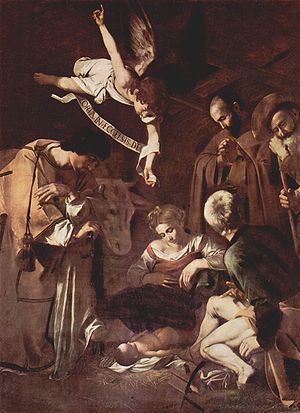
Courtesy of Wikipedia. The Nativity with St. Francis and St. Lawrence is a painting from 1609 by the Italian Baroque master Caravaggio. This gorgeous painting was stolen on October 16, 1969 from the Oratory of San Lorenzo in Palermo, Sicily. The Nativity is today the most famous unrecovered stolen painting and the FBI continue to list the work on their art thefts listings site quoting its value at $20 million. Worth is a moot point as the notoriety of the masterpiece makes it unsaleable.
Fr William Saunders wrote this sermon on the story of St Francis and the Nativity.
The story of the origin of the Christmas creche rests with the very holy man, St. Francis of Assisi.
In the year 1223, St. Francis, a deacon, was visiting the town of Grecio to celebrate Christmas. Grecio was a small town built on a mountainside overlooking a beautiful valley. The people had cultivated the fertile area with vineyards. St. Francis realized that the chapel of the Franciscan hermitage would be too small to hold the congregation for Midnight Mass. So he found a niche in the rock near the town square and set up the altar. However, this Midnight Mass would be very special, unlike any other Midnight Mass.
St. Bonaventure (d. 1274) in his Life of St. Francis of Assisi tells the story the best:
It happened in the third year before his death, that in order to excite the inhabitants of Grecio to commemorate the nativity of the Infant Jesus with great devotion, St. Francis determined to keep it with all possible solemnity; and lest he should be accused of lightness or novelty, he asked and obtained the permission of the sovereign Pontiff. Then he prepared a manger, and brought hay, and an ox and an ass to the place appointed. The brethren were summoned, the people ran together, the forest resounded with their voices, and that venerable night was made glorious by many and brilliant lights and sonorous psalms of praise. The man of God, St. Francis, stood before the manger, full of devotion and piety, bathed in tears and radiant with joy; the Holy Gospel was chanted by Francis, the Levite of Christ. Then he preached to the people around the nativity of the poor King; and being unable to utter His name for the tenderness of His love, He called Him the Babe of Bethlehem. A certain valiant and veracious soldier, Master John of Grecio, who, for the love of Christ, had left the warfare of this world, and become a dear friend of this holy man, affirmed that he beheld an Infant marvellously beautiful, sleeping in the manger, Whom the blessed Father Francis embraced with both his arms, as if he would awake Him from sleep. This vision of the devout soldier is credible, not only by reason of the sanctity of him that saw it, but by reason of the miracles which afterwards confirmed its truth. For example of Francis, if it be considered by the world, is doubtless sufficient to excite all hearts which are negligent in the faith of Christ; and the hay of that manger, being preserved by the people, miraculously cured all diseases of cattle, and many other pestilences; God thus in all things glorifying his servant, and witnessing to the great efficacy of his holy prayers by manifest prodigies and miracles.
Although the story is long old, the message is clear for us. Our own Nativity scenes which rest under our Christmas trees are a visible reminder of that night when our Saviour was born. May we never forget to see in our hearts the little Babe of Bethlehem, who came to save us from sin. We must never forget that the wood of the manger that held Him so securely would one day give way to the Wood of the Cross. May we too embrace Him with all of our love as did St. Francis.
No comments:
Post a Comment